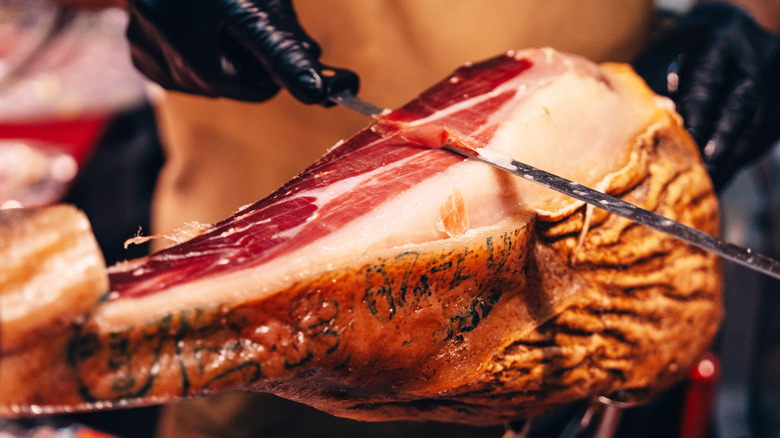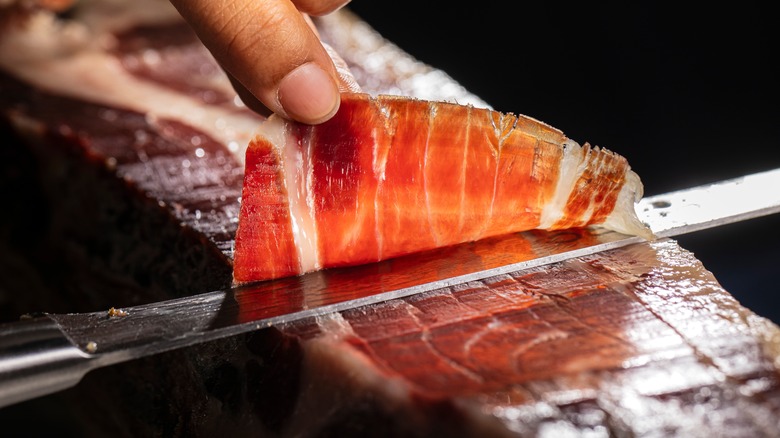Jamón Ibérico VS Serrano: The Differences Between The Spanish-Style Hams
Here at The Takeout, we've gone into the differences between city and country ham and cured and uncured ham. Now, it's time to tackle the difference between Spain's most iconic ham styles: jamón ibérico and jamón serrano. Like the delicious paella, these hams are part of Spain's national identity, and the traditional processes with which each is made are fiercely protected.
In general terms, both jamón ibérico and jamón serrano are types of cured hams. However, there are some important distinctions between them. These differences mainly boil down to the type of pig used, what the animals eat while they're growing, the conditions that they're raised in, and the length of the curing process. All of these factors affect the flavor profile of the hams, and the price each commands. Another important point of deviation is how tightly controlled each ham's place of origin needs to be in accordance with Spanish law.
If you like cured ham, you're likely a fan of both ibérico and serrano. You might even enjoy one or the other better depending on the occasion. But while we are fans of both, we do think it's important to know the difference so you don't risk confusing them on your next trip to Spain (or the supermarket). Here's the full breakdown of each type of Spanish ham.
What exactly is jamón ibérico?
To put it simply, jamón ibérico is the highest quality and most expensive type of Spanish ham. It is usually divided into four labels, ordered from lowest to highest: White, green, red, and black. Black label jamón ibérico is made from the hind leg of a 100% Iberian black pig that has been raised free-range while feeding on acorns, grass, and wild herbs. The other labels have different requirements, but all would require pigs that are at least 50% Iberian black. Curing times also have an effect on the label, and they vary between 18 months and 4 years.
Another important distinction of jamón ibérico is that it is only made in four specific places in Spain: The autonomous region of Extremadura, the comarca of Los Pedroches in Córdoba, the municipality of Guijuelo in Salamanca, and the town of Jabugo in Andalusía. The ham's controlled designation of origin means that any similar type of ham made anywhere else is not considered jamón ibérico.
Jamón ibérico's taste varies by label. But in general, this ham is known for its strong, complex flavor, and can go for over $2,000! The good news, though, is that you don't have to buy the entire leg, it's possible to try a few slices while in Spain or specialty stores around the world.
What exactly is jamón serrano?
Like jamón ibérico, jamón serrano is a type of cured ham that is a staple of Spanish cuisine. Although it's considered to be of lower quality than jamón ibérico, it is still highly regarded as one of the world's most delicious hams. Serrano ham is made with white pigs rather than the endemic Iberian black breed. They're usually fed grains and are often raised in closed pens. This diet and lack of exercise change the taste and texture of the meat.
Serrano ham is normally cured for a shorter period of time, with the typical period ranging from 7 to 16 months. However, it is also cured and dried with natural processes rather than faster industrial ones used for common hams. Though its taste is still strong, most would consider it more subtle than that of jamón ibérico. Another big difference is that jamón serrano can be made anywhere in Spain.
It's clear that these hams are definitely not interchangeable, as many people think. But while it's easy to confuse them, you'll now be able to decide which one you want to buy. Serrano is better as a weekly treat that is part of your usual grocery haul, while ibérico is perfect for special occasions when you want to really treat yourself. Either way, they'll both beat most other hams at the deli.


